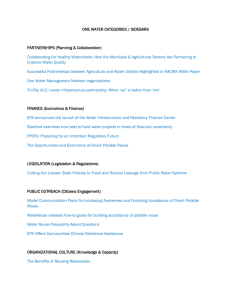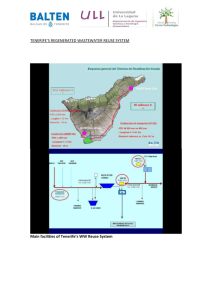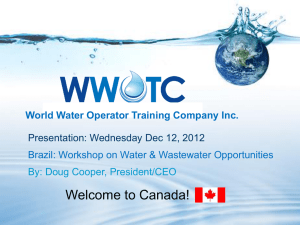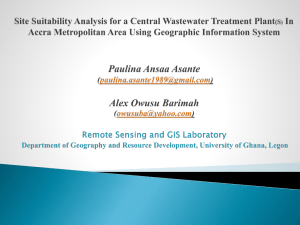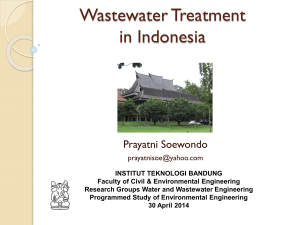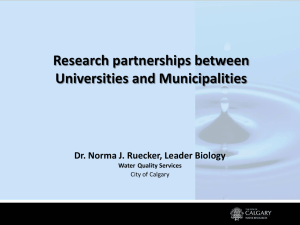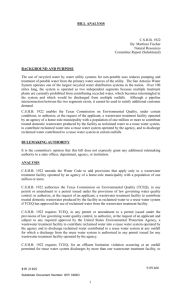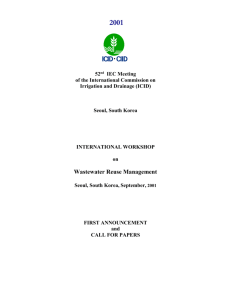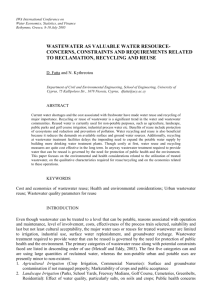Powerpoint
advertisement
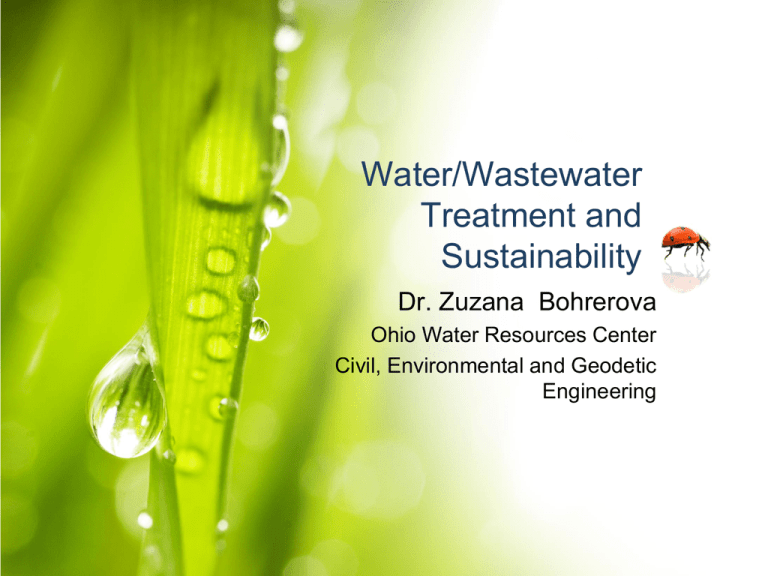
Water/Wastewater Treatment and Sustainability Dr. Zuzana Bohrerova Ohio Water Resources Center Civil, Environmental and Geodetic Engineering ASCE sustainable water resources systems “water resources systems designed and managed to fully contribute to the objectives of society, now and in the future, while maintaining their ecological, environmental and hydrological integrity” Are we using water in sustainable manner? Water Scarcity water withdrawal as percentage of total available more than 40% 40%-20% • • • 20%-10% less than 10% 41% of the world’s population lives in river basins suffering from moderate to high water stress Biofuel use and increasing population growth will increase the percent of the world population living in water stressed areas Some hypothesize that major wars will be fought over water rights (water does not respect political borders!) Access to Clean Water • Over 1 billion people lack access to safe drinking water - unhealthy to drink (world population: 6.8 billion) Access to Sanitation • 2.5 billion people do Regional medians for sub-Saharan Africa Simple pit latrine not have “improved (Improved) Open pit latrine sanitation” (separation (Unimproved) of human from their Pour-Flush latrine (Improved) wastes) Connection to septic system (Improved) • Approximately 300 Other (Unimproved) million of urban Ventilated improved pit latrine (Improved) residents have no None (Unimproved) access to sanitation Shared or public latrine (Unimproved) Bucket latrine (Unimproved) Connection to public sewer (Improved) Some more sustainable WWT technologies- developing world • Lagoons/wetlands – Climate – Land – Reuse potential? • Anaerobic digesters (USAB) – Small and large scale – Biogas production and stable humus – Operation • SAT (Soil Aquifer Treatment) technologies – Partially treated effluent used for recharge (Gaza) – Breaks pipe-to-pipe connection – Could lower WQ of groundwater Significance of Water Resources – U.S. perspective Drinking water in US is among the best in the world, BUT • Emerging contaminants threaten our water supplies – Microcystin, Perchlorate, Arsenic, PHACs • Development in arid, coastal regions • Many waters are not “fishable and swimmable” • Water/wastewater infrastructure security Water is sustainable renewable resource, right? http://www.nap.edu/openbook.php?record_id=12672&page= 52 (Toward a Sustainable and Secure Water Future: A Leadership Role for the U.S. Geological Survey (2009) Water Science and Technology Board) Water Use Water Withdrawals by Sector Agricultural World Asia (Not Middle East) Central America & Caribbean Europe Industrial Middle East & North Africa North America Domestic Oceania • Agriculture dominates water use South America SubSaharan Africa Sustainable Water Resources Management Goals • Kennedy and Tsuchihashi, 2006, Is Water Reuse Sustainable? Water sustainability in agriculture Water sustainability in agriculture • Choose the right crops for specific areas • Improve water harvesting and storage and soil water retention (organic soils) • Manage irrigation for efficiency – Drip irrigation – Time of irrigation – forecasting and scheduling • Using reclaimed water for irrigation http://www.scientificamerican.com/article/al l-the-food-using-half-the-water-video/ Water Reuse for Irrigation • Most reclaimed water contain TDS – salts • Irrigation needs to be evaluated for long term sustainability of soil resources • Salt accumulation in soils – change in root osmosis and ability to grow (uptake nutrients and water) • Israel about 70% reuse water used for irrigation – salinity problem. – Strict source control (what is discharged into wastewater) – Changes in water softening agents and detergents • Emerging contaminants Current Urban Water Cycle 5% Q Waste sludge, brine (to disposal) Groundwater or surface water inputs (Q) WTP Loss to leakage (33%Q) City Distribution System Outfall 57-66% Q Waste sludge, brine (to disposal) 5% Q WWTP • Linear treatment system based on disposal Electricity Use for Water/Wastewater Treatment in US • Uses 4% of nation’s electricity • Majority for moving water/wastewater (80%), rest treating • Groundwater supply as water source requires 30% more electricity (versus surface water) • Increases in energy consumption: – Age of delivery systems (friction increase, efficiency decrease) – Conservation (systems will operate on below minimum level; trend to smaller system; economies of scale) – Improve treatment requirements – Advanced wastewater treatment 3x more electricity than trickling system Drinking water treatment • EPRI Wastewater treatment Current Urban Water Cycle • Current urban wastewater management is linear treatment system based on disposal – Abuse of water for diluting human excreta – High cost for running and operating current systems – Collection infrastructure and fast development • Need of sustainable, closed-loop urban wastewater management system based on conservation of water and nutrients Current water/wastewater treatment Water scarcity High energy needs Aging infrastructure NEW OPPORTUNITY New technology development Water recirculation locally Next generation approaches testing Approach to Water Infrastructure Traditional New Sustainable Rapid conveyance – underground concrete pipes and large treatment plants Keep significant portion of the source, use, treatment, and/or disposal at the local level (site) Goal – protect public health and receiving water, flood control Expand to lighter ecosystem footprint and enhanced community benefits Industrial model of specialization Integrate water, wastewater and stormwater – One water Siloed infrastructure, funding, regulations and management Multiple uses and reuses Driver – economies of scales – bigger is better True cost pricing - externalities Potable water for all uses Water quality sufficient for intended use Nelson, Sustainable Water Infrastructure Water Reuse • Not the only solution • Needs to be combined with: – – – – – water conservation alternative water supply green infrastructure development in treatment technologies environmental restoration Water Quality Change • Electricity consumption decreases sustainability of water reuse (LCA) Reclaimed water use Domestic Water Reuse – dual reticulation Water corporation, Australia, published online Consideration for dual-reticulation Water corporation, Australia, published online Water reuse and treatment process Reverse Osmosis Advantages Disadvantages Modular assembly system Water needs extensive pretreatment Installation cost low Interruption during stormy weather (too many organics in feed water) High space/production capacity ratio Need for extensive spare parts inventory Low maintenance Brine disposal Removes TDS Energy costs Negligible environmental impact Needs reliable energy source Minimal use of chemicals Membrane fouling Future development: better membranes, lower energy requirements San Diego San Diego toilet to tap • Facility available and treating wastewater • Regulations not in place • Public oppose direct potable use, but willing to use as indirect potable use http://www.sandiego.gov/water/purewater/demo/index.shtml • Toilet to tap feasible – biggest hurdle is public perception Scientific American, CREDIT: Sam Kaplan; STYLING BY LINDA KEIL Halley Resources Blue Print Columbus • Sanitary sewer overflows has to be eliminated • Solution – Green infrastructure – OARS deep sewer tunnel http://www.youtube.com/watch?v=do6jFv_HdbE&feature=youtu.be References • Kennedy, L. and Tsuchihashi, R. (2005), “Is Water Reuse Sustainable? Factors Affecting its Sustainability. The Arabian Journal for Science and Engineering, 30(2C), 3-15 • Jhansi, S.C. and Mishra, S.K. (2013), “Wastewater Treatment and Reuse: Sustainable Options”, Consilience: The Journal of Sustainable Development, 10(1), 1-15

